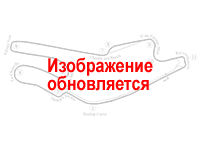
Phillip Island Circuit

Длина кольца: 4448 метров (2.764 мили)
Ширина трека: 13 метров
Самая длинная прямая: 900 метра (0.559 мили)
Левых поворотов: 5
Правых поворотов: 7
Часовой пояс: МСК +6
Предоставлено Gismeteo.Ru
Погода на треке
25/12
НОЧЬ
+12 +14CНОЧЬ

Ветер: Ю-З, 1 м/с
Отн. влажность: 64-66%
Атм. давление: 759-761 мрс
25/12
УТРО
+12 +14CУТРО

Ветер: Южн., 3 м/с
Отн. влажность: 58-60%
Атм. давление: 760-762 мрс
25/12
ДЕНЬ
+15 +17CДЕНЬ

Ветер: Южн., 4 м/с
Отн. влажность: 48-50%
Атм. давление: 761-763 мрс
25/12
ВЕЧЕР
+13 +15CВЕЧЕР

Ветер: Южн., 5 м/с
Отн. влажность: 51-53%
Атм. давление: 761-763 мрс
Описание, история и факты.
Phillip Island is one of the greatest MotoGP tracks in the world . The fast flowing nature of the 4.448 km circuit is the reason that makes Phillip Island one of favourite MotoGP tracks among riders for the last 15 years. The one big drawback can be weather on this outpost of South Australian coastline . Heavy rain and winds can cause chaos at this time of the year to the Island, which is linked by a bridge to the mainland, some 100 kms south of Melbourne.
The track, which is the second fastest in the MotoGP calendar, requires complete riding skills. There are five right and seven left hand corners and 900 meters start and finish straight which leads into the very quick Doohan right hand bend.
Tradition of racing on Phillip Island is 75 years long, but the permanent circuit was built in 1956. It fell in to disrepair but had a complete revamp in the mid eighties and staged the very first Australian MotorCycle Grand Prix in 1989.
First Phillip Island race was won by Australia´s first 500cc World Champion Wayne Gardner and the whole country celebrated his success. Valentino Rossi has incredible record of 4 consecutive wins on this track from 2001 to 2004.
Phillip Island - Technical Details
The average lap speed is 177.785 km/h, making it the second fastest track of the World Championship calendar behind Assen. This high speed would seem strange at a circuit with very few straights, however, although the main straight is relatively short at less than 900 metres long, the corner leading onto it and the corner at the end of it are both extremely fast corners taken at more than 180 km/h.
The ideal settings would give the bike stability to be able to take the fast corners with as much precision as possible and use the maximum amount of track surface. There are six corners taken at over 180 Km/h and three of these are negotiated at more than 200 Km/h.
Given the presence of these high speed corners, and the constant changes of direction at high speed, technicians tend to fit hard springs so that when the rear of the bike is under compression the riding precision is not affected and the rider can maintain the racing line through corners. However, the presence of many bumps on the track surface means that the springs to be fitted cannot be as hard as we would like. To demonstrate the pressure on the springs, the point of greatest compression of the rear of the bike takes place between corners seven and eight where the bike is travelling at more than 230Km/h. This speed creates a force of more than 500kg on the rear springs.
Regarding the front suspension, the points in the circuit where there is most movement of the front shocks are the two hairpins taken at slow speeds. The rider must brake hard at these two points, but this is not a circuit where hard front springs are fitted because of hard braking. Due to the bumpy track surface in the fast corners, softer springs are fitted in the front to maintain the precision and the grip, even through these bumpy areas. Some of these bumps are so big that the bikes literally take off as they lose contact with the track in both the front and rear. The best place to witness this is at the end of the straight where the bikes leave the ground at more than 305 km/h.
In Phillip Island the gear ratios are a little special since the higher gears are used more frequently than is usual. Most of the corners are taken in third, fourth and even fifth gear. These gears must be set so that there is not too large a step between them and also so that sixth can accommodate speeds of nearly 350 km/h. It is not always easy to find a good compromise. Unlike most other tracks in the MotoGP calendar, there are only two corners taken in first and two taken in second.
Another special factor at Phillip Island is rear-tyre wear. As well as being a very abrasive track, the characteristics of the layout of the track put an excessive amount of stress on the rear tyre. The left side of the tyres is critical since the left-handed corner onto the straight is very fast and the rider can open the throttle early, and in doing so heating the left side of the tyre to temperatures that can affect the tyre´s durability. Sometimes we must sacrifice the rear suspension settings and make them softer to prolong the life of the rear tyre so that it lasts the race distance of 120 km.
Another important aspect at this circuit is the front brake. There are no hard braking areas around the track so brake discs with smaller diameters are fitted so that they reach the correct working temperatures more easily. At Phillip Island discs of 305mm diameter are fitted compared to a normal diameter of 320mm.
Как добраться до трассы.
Трасса расположена в 100 км к югу от Мельбурна.
Из аэропорта Мельбурна по Tullamarine Freeway, соединяющей центр города с аэропортом. Не забудьте купить "проездной2 для проезда по этой платной скоростной трассе! Затем проезжаете через Мельбурн по Monash Freeway, проезжаете через Cranbourne и по Bass Highway на San Remo. Минуете мсот на Phillip Island, следуя указателям, двигатесь по Back Beach Road, на котором и находится трасса.
Контактная информация.
Track web address: http://www.phillipislandcircuit.com.au/
Phillip Island Circuit
BMB 500GP
Cowes VIC 3922
Phillip Island
Australia
Tel: +61 3 5952 2710
Fax + 61 3 5952 3160



